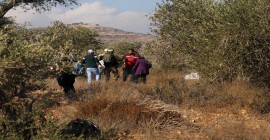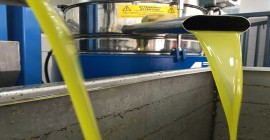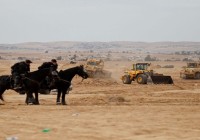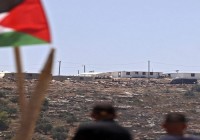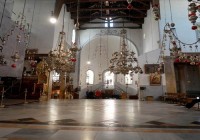The Prime Minister sets the work for the Agricultural Cluster in Qalqilya
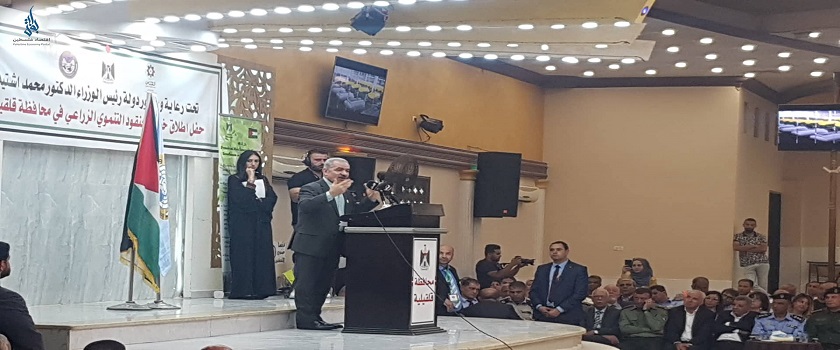
Hasna’ Al-Rantisi - Palestine Economy Portal
Prime Minister Dr. Mohammad Shtayyeh opened the activities of setting Qalqilya governorate to be the first agricultural cluster in partnership with the private sector, municipalities and competent authorities. The plan will contribute to economic development and provide thousands of jobs for citizens in all governorates.
The agricultural clusters plan is a development perspective that leads to economic disintegration and the independence of the Palestinian economy in a way that suits the specificity of the Palestinian situation.
Qalqilya: Garden of Palestine
The concept of economic clusters is based on the creation of horizontal development, in the sense of creating an advanced infrastructure in all governorates, and then moving to vertical development; investing the advantages of each province in order to strengthen the national product, and within the framework of the gradual disintegration of economic dependence imposed on us by the reality of the occupation.
It was considered d. The first phase of this comprehensive economic plan will enable the governorate to take on the role of the Palestine Vegetables and Fruits Park. $ 23,194 million will be invested in the province in partnership with the private sector and civil society, and will be spread over three years.
The cluster will extend to expand other clusters
"The cluster will expand in the coming months to include Tubas, Jenin and Tulkarem. It will be followed by industrial clusters in Nablus and Hebron, tourism in Bethlehem, services administration in Ramallah, and other clusters that will cover all the provinces of the homeland," Shtayyeh said.
Challenges and outputs
Shtayyeh expected that there will be certain outputs that will increase the area of irrigated agricultural area by 37% over the current irrigated agricultural area, and an increase of plant production by 25% -30% from current production. With the cultivation of 180,000 fruit seedlings and the increase of new agricultural areas by about 5000 dunams, in addition to the construction and rehabilitation of 360 km of agricultural roads that will serve 32,000 dunams.
As each economic action has limitations and constraints, this development plan has challenges in the governorate, such as occupation and its policies and practices, limited agricultural land and water resources, in addition to limited technical and marketing capabilities.
The pillars of the plan are to address the effects of destruction resulting from the occupation and access to agricultural land, water and natural resources and markets, as well as increasing investment in the agricultural sector and activating the role of start-up agricultural institutions, while exploiting international agreements and treaties to develop Palestinian agriculture.
The plan is, technically..
The plan includes several steps such as the management of natural resources such as the transfer of water to the eastern areas, supply and installation of major water lines, support and rehabilitation of wells, reclamation and protection of land, rehabilitation of roads and construction of others.
New areas will be cultivated with strategic and high-value crops, while improving the business environment in agricultural production, processing and marketing, which will be supported by cooperative societies and rural women, and the establishment of pre-harvest houses and post-harvest facilities.
Farmers and Producers affected by the practices of the occupation will also be supported with agricultural loans.
Stressing the work in the field of community awareness and the development of a secondary agricultural branch in the province of Qalqilya.
In the details of the technical plan, there will be 50 km of water transmission lines, with the rehabilitation of 10 underground wells, the establishment of 8 irrigation units, the support of fuel for 6 wells behind the wall, as well as the provision of 10 wells with solar energy units, and the conversion of 6 wells behind the wall to work with electricity.
Regarding the development of the land, the plan includes the reclamation of 2500 dunams and rehabilitation of the same number of dunams, as well as the protection of 500 dunams in the fence, with the construction and rehabilitation of 360 km of agricultural roads.
Shtayyeh’s plan also referred to the introduction of strategic crops and the cultivation of 1000 dunams of subtropical crops, as well as the establishment of five fish ponds, with 180,000 trees planted.
The form of support for production products will be as planned by the establishment of a plant for nurseries, and the establishment of a laboratory for the production of queen bees, as well as the establishment of laboratory for testing water and soil, with the establishment of five workshops for bee supplies.
It is worth mentioning that Qalqilya Governorate is located in the northwestern part of the West Bank, with an area of approximately 170,000 dunams. It has a population of about 112,400 and is considered one of the most important agricultural governorates in the West Bank.
